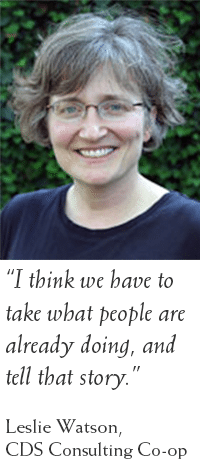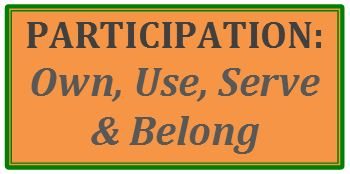 The democratic structure of cooperatives allows people the opportunity to have a real influence on business goals and outcomes through their investment, patronage, feedback, and aspirations. It’s one of the most defining features of cooperation, especially compared to
The democratic structure of cooperatives allows people the opportunity to have a real influence on business goals and outcomes through their investment, patronage, feedback, and aspirations. It’s one of the most defining features of cooperation, especially compared to  other business models where social or environmental impact may be considered incidental. In cooperatives, concern for community is one of our principles and purpose. In 2012, the International Cooperative Alliance recognized the importance of owner engagement in its Blueprint for a Cooperative Decade.
other business models where social or environmental impact may be considered incidental. In cooperatives, concern for community is one of our principles and purpose. In 2012, the International Cooperative Alliance recognized the importance of owner engagement in its Blueprint for a Cooperative Decade.
“Participation” is one of the Blueprint’s five key themes (the others are sustainability, identity, capital and legal frameworks). The goal as stated in the Blueprint is to “elevate participation within membership and governance to a new level.” It’s how cooperatives will maintain their relationship with current owners and remain relevant to a new generation. It’s also a potent reminder that the work of implementing organizational democracy is always in process.
Participation is not about getting members to do more for their co-ops. Quite the opposite. It’s about getting input. Sharing information. Recognizing talent. Inviting new people to the table. Valuing shoppers. Being generous with resources. Participation is the means to achieving the co-ops Ends, not the end itself. By focusing on outreach, more involvement may result in higher sales, better morale, and more people becoming co-op owners. Participation manifests the power of belonging.
 Participation as a co-op owner is also key at certain times in the life of the co-op. The co-op will need people to patronize it, give input, vote and provide capital. That’s why building a shared understanding of the co-op’s purpose is critical. CDS Consulting Co-op has developed a paradigm for approaching how participation occurs in a cooperative: own, use, serve and belong. The purpose is for people to understand how they benefit as well as how they contribute to the common good by being an owner and using the co-op, and to understand that by doing these things they are already serving the co-op and belonging to a community of shared values. At every level of the organization, greater participation of each stakeholder could result in the following outcomes:
Participation as a co-op owner is also key at certain times in the life of the co-op. The co-op will need people to patronize it, give input, vote and provide capital. That’s why building a shared understanding of the co-op’s purpose is critical. CDS Consulting Co-op has developed a paradigm for approaching how participation occurs in a cooperative: own, use, serve and belong. The purpose is for people to understand how they benefit as well as how they contribute to the common good by being an owner and using the co-op, and to understand that by doing these things they are already serving the co-op and belonging to a community of shared values. At every level of the organization, greater participation of each stakeholder could result in the following outcomes:
| Own | Use | Serve | Belong | |
| Members/Customers | Increase in joining rates
Greater equity, retained patronage, financing. |
Enlarge basket size to member shoppers. | Boost Word of Mouth.
Enhanced reputation. |
Expand community owners/partnerships/
networks. |
| Staff | Demonstrate stake in co-op. | Act to maintain facility, equipment, and inventory.
Pride in work. |
Understand co-op model.
Educate others. Intensify customer satisfaction. |
Build teamwork. |
| Management | Operationalize values, interpret Ends. | Strengthen common goals.
Worker retention. |
Excellent staff treatment.
|
Improved workplace culture.
Promote positive attitude. |
| Board | Clarify co-op mission and purpose. | Empowered accountability.
Better decision making. |
Improved leadership capacity. | Encourage more co-op leaders. |
Just like the development of a cooperative culture, participation is something that is cultivated within the organization. That’s why cooperative organizations need to continually improve their ability to:
- Increase co-op visibility on multiple platforms
- Have a meaningful narrative (with the co-op as hero)
- Engage in best practices that support strong performance of the business
- Connect members with opportunities to meaningfully impact their co-op
- Innovate to increase recruitment of new members
Increase co-op visibility and tell story
 Recent cross-sector research (food co-ops, credit unions, electrical, housing, insurance) commissioned by the National Co-op Bank with people of all incomes and races revealed that only 11 percent of the population in all regions around the United States have some understanding of cooperatives. Of the 11 percent, most believed cooperation was only sector specific (for example believing food co-ops were the only kind available because they didn’t know about credit unions, or vice versa). This same survey revealed that once cooperation was explained to them, 78 percent of respondents said that they would be more likely to purchase from a cooperative than any other business. Clearly there is a huge opportunity for cooperatives to be more visible to consumers in the marketplace.
Recent cross-sector research (food co-ops, credit unions, electrical, housing, insurance) commissioned by the National Co-op Bank with people of all incomes and races revealed that only 11 percent of the population in all regions around the United States have some understanding of cooperatives. Of the 11 percent, most believed cooperation was only sector specific (for example believing food co-ops were the only kind available because they didn’t know about credit unions, or vice versa). This same survey revealed that once cooperation was explained to them, 78 percent of respondents said that they would be more likely to purchase from a cooperative than any other business. Clearly there is a huge opportunity for cooperatives to be more visible to consumers in the marketplace.
Cooperatives have a tendency to downplay their contributions, and magnifying what they already do is one straightforward strategy that could have a powerful impact. “It’s an untapped potential, to illuminate the co-op’s actions and contributions to the broader community,” said Leslie Watson, board leadership development consultant. “I think we have to take what people are already doing, and tell that story.”
Ben Sandel, leadership development and capitalization consultant agreed. He noted that the so-called sharing economy has captured global attention because it is perceived as a different model, while cooperatives, long built on shared values, go unnoticed. “Co-ops do great stuff every day, but people have no idea,” he said.
Engage in best practices
Being the best business by gathering data and using proven tools and techniques to improve is a big factor in a co-op’s ability to extend an invitation to stakeholders to participate. “Being a fantastic grocery store is a really valuable thing,” said Sandel. Strong co-op performance is linked to a number of factors, including financial success, employee satisfaction and community impact.
“Part of participation is having owners who like the co-op and use it. That way the co-op’s operation builds a stronger connection to its customers and owners. You want people to think ‘supporting the co-op is worth it to me.’” Sandel added. Excellence as business and community leaders gives more people the opportunity for real and meaningful engagement.
Connect members with opportunities to impact co-op
The fear of asking people for money is probably equally matched by the dread a lot of people feel about public speaking. However, capital campaigns are incredibly powerful because they connect co-op members with an important opportunity to impact their co-op, while also benefiting from knowing their money isn’t subject to the vagaries Wall Street and global finance.
Owner participation does something meaningful, and investing raises owner awareness that it’s an important part of a co-op’s long-term viability. Why wouldn’t the co-op include owners in this important activity? “Financing expansions and improvements in our stores matters, and it’s worthwhile,” Sandel said.
Increase member recruitment
In order to create a connected network of cooperators, it’s important to find new ways to invite people to be owners of the co-op. This includes developing strategies and annual goals to reach out to a variety of diverse communities. Membership development needs to go beyond the typical parameters, to include people in conversations of all sorts—be it social media, in-person gatherings or within food co-op aisles. “I think some of our challenge is to overcome a certain amount of stodginess regarding how to include people,” Watson said.
Watson suggests starting with finding small steps that can move people along a continuum of co-op awareness. How do we encourage people to consider joining the co-op? “You invite people to have an emotional connection,” she said. “Cultivate the seed and allow it to take root. Let the co-op be a place for people to connect not just to goods and services they want, but to playfulness and joy.”
Have more questions?
Get in touch with one of our consultants.
